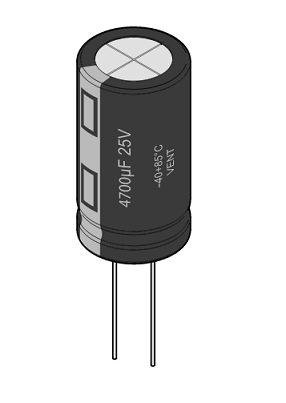Capacitance

Capacitance is the ability of an object (material in a particular geometry) to store an electric charge. Specifically, it is a measure of an isolated conductor's ability to store charge at a given voltage difference.[2] In this sense, an object's capacitance is the ratio between its charge at a particular voltage difference and that voltage difference. Functionally, this leads to capacitance also being a measure of how much energy a capacitor can store.
Often a capacitance is thought of as being the physical property of a capacitor that has two conducting plates close to each other. The capacitance is described mathematically as:
Capacitance is measured in farads (F), with 1 farad representing 1 coulomb per volt. This means that if an isolated conductor had a capacitance of 1 farad and was charged with 1 coulomb, it would have a voltage of 1 volt on its surface. There is also an alternate way to determine the capacitance of a capacitor if its dimensions are known. If the area of the plates of the capacitor can be determined, the capacitance can be calculated from the expression:[3]
- is the capacitance, measured in farads (F)
- is a constant called the permittivity of free space = 8.854188x10-12 F/m [4]
- is the relative permittivity of the material between the plates
- is the surface area of the plates of the capacitor, measured in square metres (m2)
- is the distance between the plates, measured in metres (m)
The equation shows that the capacitance is influenced by the dimensions of the capacitor.
For Further Reading
- Capacitor
- Conductor
- Voltage difference
- Coulomb
- Voltage
- Or explore a random page
References
- ↑ "Electrolytic Capacitor, Radial, 16x30 (Coloured)" Licensed under Public Domain via Wikimedia Commons - http://commons.wikimedia.org/wiki/File:Electrolytic_Capacitor,_Radial,_16x30_(Coloured).svg#/media/File:Electrolytic_Capacitor,_Radial,_16x30_(Coloured).svg
- ↑ P. Tipler and G. Mosca, "Electrostatic Energy and Capacitance," in Physics for Scientists and Engineers Volume 2, 5th ed. Freeman, ch. 24, pp. 752-755
- ↑ R. Kotz and M. Carlen, "Principles and applications of electrochemical capacitors," Electrochim. Acta, vol. 45, no. 15-16, pp. 2483-2498, May 2000.
- ↑ A. D. McNaught and A. Wilkinson. (2012, September 8). Permmittivity of vacuum [Online]. Available: http://goldbook.iupac.org/P04508.html

